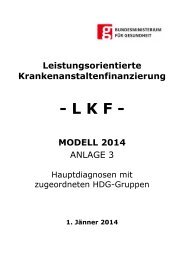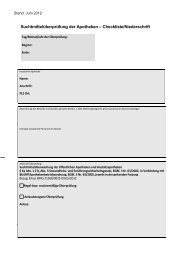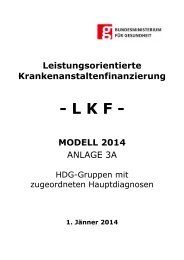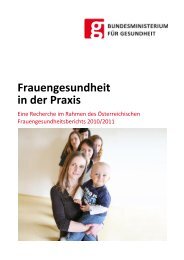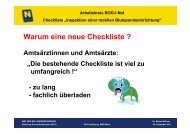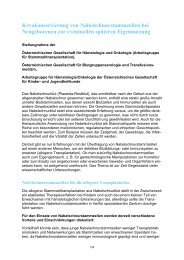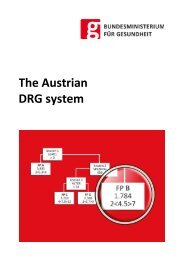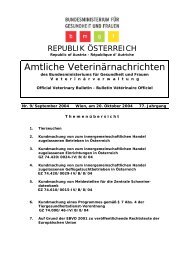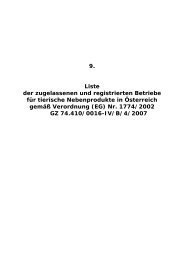Report on the Drug Situation 2010 - Bundesministerium für ...
Report on the Drug Situation 2010 - Bundesministerium für ...
Report on the Drug Situation 2010 - Bundesministerium für ...
You also want an ePaper? Increase the reach of your titles
YUMPU automatically turns print PDFs into web optimized ePapers that Google loves.
Figure 5.1<br />
Number of people entering drug treatment in 2009, by age and type of service<br />
Number of clients since 2009<br />
1 950<br />
1 800<br />
1 650<br />
1 500<br />
1 350<br />
1 200<br />
1 050<br />
900<br />
750<br />
600<br />
450<br />
300<br />
150<br />
0<br />
56<br />
18<br />
33<br />
6<br />
1 645<br />
1 474<br />
1 259<br />
1213<br />
1 010<br />
957<br />
789<br />
753<br />
701<br />
562<br />
530<br />
442<br />
257 262<br />
160<br />
116 133<br />
138 106 125<br />
14 or younger 15-19 years 20-24 years 25-29 years 30-34 years 35 or older<br />
Short-term c<strong>on</strong>tacts (n = 6 233) Low-threshold services (n = 663)<br />
L<strong>on</strong>g-term outpatient treatment (n = 4 187) L<strong>on</strong>g-term inpatient treatment (n = 1 662)<br />
Source: GÖG/ÖBIG <strong>2010</strong>a, DOKLI analysis of client year 2009; representati<strong>on</strong> by GÖG/ÖBIG<br />
In <strong>the</strong> traditi<strong>on</strong>al treatment settings (l<strong>on</strong>g-term outpatient or inpatient treatment),<br />
opioids predominate as primary drugs 24 . Cocaine c<strong>on</strong>tinues to be irrelevant as far as<br />
primary drugs are c<strong>on</strong>cerned (see Figure 5.2 and Table A26 in Annex A). This shows<br />
that in Austria, different to a number of o<strong>the</strong>r countries of <strong>the</strong> European Uni<strong>on</strong>, opioids<br />
24<br />
For compiling <strong>the</strong> DOKLI case history, clients are first asked to name all drugs <strong>the</strong>y have ever taken. Then <strong>the</strong><br />
drugs menti<strong>on</strong>ed are classified according to current patterns of use, as primary drugs, additi<strong>on</strong>al drugs, drugs<br />
<strong>on</strong>ly taken in <strong>the</strong> c<strong>on</strong>text of experimental use and drugs not relevant for treatment. The primary drug is <strong>the</strong><br />
drug which causes <strong>the</strong> greatest problems from <strong>the</strong> pers<strong>on</strong>al point of view of <strong>the</strong> client. Here, problems – <strong>on</strong> <strong>the</strong><br />
basis of ICD 10 – are understood as psychosocial and health-related problems and not solely legal problem<br />
situati<strong>on</strong>s. As a rule, <strong>the</strong> primary drug is <strong>the</strong> drug because of which <strong>the</strong> client has started <strong>the</strong> current treatment.<br />
If a client cannot decide which drug is <strong>the</strong> primary drug, several drugs may be named. Additi<strong>on</strong>al drugs are<br />
drugs which <strong>the</strong> client has used in additi<strong>on</strong> to <strong>the</strong> primary drug in <strong>the</strong> past six m<strong>on</strong>ths and which also c<strong>on</strong>stitute<br />
a problem for <strong>the</strong> client. Experimental drug use refers to intermittent use of <strong>the</strong> corresp<strong>on</strong>ding drug in <strong>the</strong> past<br />
six m<strong>on</strong>ths without harmful use or manifest addicti<strong>on</strong> problems. <strong>Drug</strong> use not relevant for treatment means<br />
that <strong>the</strong> drug in questi<strong>on</strong> has occasi<strong>on</strong>ally been taken over a period of more than half a year but no harmful use<br />
or manifest addicti<strong>on</strong> problems show, or that <strong>the</strong> drug was used in <strong>the</strong> past but not during <strong>the</strong> six-m<strong>on</strong>th<br />
period preceding treatment (GÖG/ÖBIG <strong>2010</strong>a).<br />
Chapter 5 / <strong>Drug</strong>-related Treatment: Treatment Demand and Treatment Availability 45



